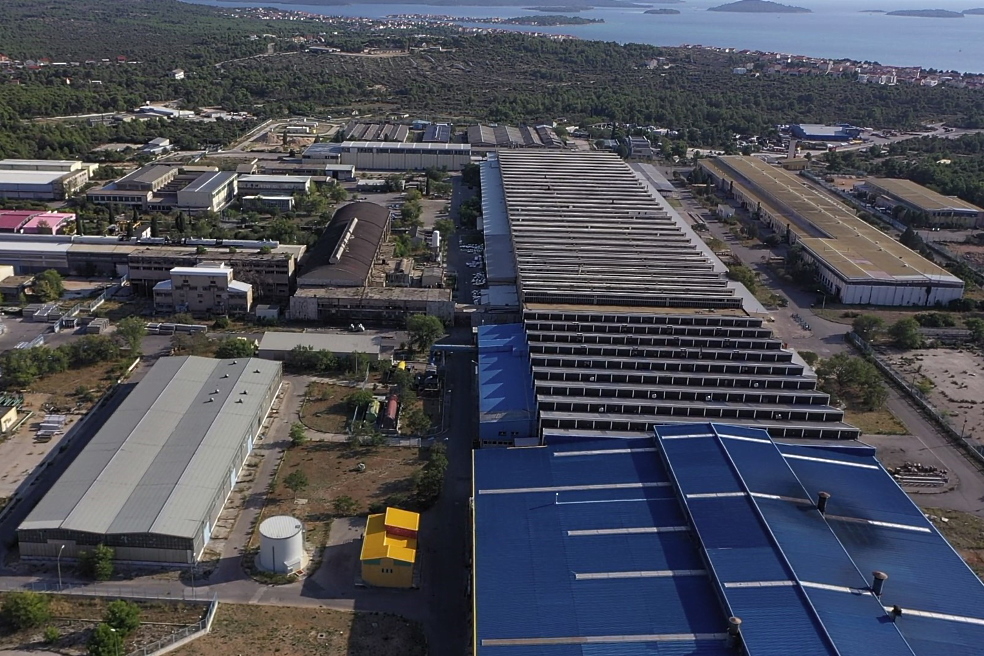Financing and lending services for industrial construction projects
ESFC Investment Group offers:
• Investment financing from €50 million and more
• Minimizing the contribution of the project promoter
• Investment loan term up to 20 years
• Loan guarantees
At the same time, the vast majority of construction companies do not have sufficient internal resources to implement such projects, so investment success depends on the funds attracted in financial markets.
However, against the background of a difficult economic situation and energy crisis, banks are reluctant to finance industrial construction projects, which are associated with significant risks.
Sources of financing the construction of industrial facilities
When a developer company chooses ways to finance its projects, it proceeds from the need to solve the main problem of financing industrial construction.The question is how to get money for a long period of construction (usually about 3-5 years) without an immediate return, while continuing to bear a heavy tax burden and fulfilling its obligations in an unpredictable crisis environment?
The specificity of industrial property makes it difficult to finance construction of plants, factories and warehouses on a general basis, that is, by receiving advance payments from the future owners of the areas under construction.
Based on the main problem formulated above, developers can use the following ways of financing projects:
• Obtaining an advance from a potential buyer with subsequent long-term contracts.
• Placement of bonds among the future owners of an industrial facility.
• Long-term loans from financial institutions, primarily from large banks.
• Establishment of a construction financing fund, etc.
In addition, the developer can use another important mechanism of attracting funds, which, however, is used to a limited extent in developing countries.
We are talking about the construction of industrial facilities by concluding agency contracts, when the developer will act as an agent of the future owner, carrying out construction on his behalf and at his expense.
Despite the rapid development of the legislative framework, which ensures the development of lending to construction projects, the main restraining factors continue to be the low creditworthiness of businesses due to economic instability, the slow development of secondary securities markets in some countries, as well as refinancing difficulties.
There are some problems hindering the development of bank lending for industrial construction:
• The scale of long-term construction lending is limited by the short-term resource base of banks, as an increase in the share of long-term loans can lead to a decrease in liquidity.
• The high cost of loans, which is a consequence of the high price of borrowed resources for banks and the high risks of financing industrial projects, which are taken into account by banks in interest rates on loans.
• The difficulty of assessing the solvency of potential borrowers, which becomes an even greater problem due to rapid changes in international markets, rising energy prices, geopolitical tensions and sanctions restrictions.
As international investment practice shows, an important role in financing the construction of industrial real estate is played by such mechanisms as securities issuance, long-term lending and mixed financing with the simultaneous application of several options depending on the needs of a specific project.
Mechanisms and sources of financing for the construction of industrial facilities depend on the characteristics of the project, the specific sector and the way of its future use (for example, a warehouse, a processing plant, a terminal).
Determining the cost of capital plays an important role in making decisions about attracting sources for financing industrial construction.
The optimal capital structure expresses such a ratio of equity and loan capital that provides the best possible profitability indicators. Most often, the effect of financial leverage is used to solve problems of optimizing the structure of investment capital.
The effectiveness of attracting funds to finance long-term crediting of construction is affected by the presence of reliable financial instruments that provide lenders with resources in the required scale at a relatively low cost and in adequate terms.
Loans for the construction of industrial property
Industrial property is considered a relatively low-risk long-term investment with high returns.However, high capital costs make self-financing of large projects difficult for most developers, especially given the long period between the first costs and the return on investment. This gap causes the spread of attracting financial external resources to industrial construction projects.
Although most industrial buildings are built to the order of a particular company, the developer needs to demonstrate a direct interest in the successful implementation of the project to ensure the trust of partners. In this context, a certain proportion of the total funding (often up to 25-30%) is provided by the developer's internal resources. As a rule, we are talking about the initial stage of the project, including the search for a land plot, the development of a concept and engineering solutions in accordance with the client's order, as well as obtaining permits and approvals.

The use of loans for industrial construction is critical, especially when it comes to capital-intensive projects.
With, for example, $50 million, a developer can independently implement one project with a budget of $50 million, or it can attract 80% external financing to complete five similar projects within the same time frame.
The effect of financial leverage drives the highly competitive industrial construction sector, so lending plays an important role among developers' funding sources.
Currently, the long-term loan is the main source of external financing for industrial construction projects.
Compared to other sources (share placement, bonded loan), the advantages of a bank loan are the relative simplicity of the procedure and the attraction of resources according to a customized scheme that takes into account the specific needs of a particular project in terms of amount and timing.
However, the bank seeks to a large extent to control the progress of the project and compliance with the principle of targeted use of financial resources provided under the loan agreement, often interfering in the management of the project.
The advantage of the loan is the use of the effect of financial leverage with relatively limited intervention of the donor of financial resources in project management. In turn, equity financing allows you to obtain financial resources at a lower cost. Theoretically, the cost of equity capital should be significantly lower than the cost of financial resources raised through bonds and loans.
In practice, as experts note, the money of co-investors often turns out to be quite expensive, which can be explained by two reasons listed below:
1. Given the current level of profitability of industrial property, attracting co-investors may be more expensive than using a loan, the cost of which is fixed and does not depend on the success of investment project as a whole.
2. Since the rights of minority shareholders in many developing countries are poorly protected, and attracting a large co-investor forces the developer to provide him with a significant block of shares as guarantees to protect his interests, this scheme can be dangerous.
Comparisons between bonded loans and traditional loans also provide mixed results.
Other things being equal, a bond loan, according to most experts, is more effective, as it makes it possible to raise funds on a large scale and at a lower interest rate than a bank loan. When obtaining a bonded loan, no collateral is required, and it is also possible to adapt the terms of issue (interest rate, terms of circulation and redemption) to the specific needs of the project. The lender does not interfere with the implementation of the project.
The use of bonds to finance the construction of industrial property has a number of disadvantages:
• High level of expenses for attraction of financing.
• A complex procedure for organizing the issue and placement of bonds.
• The need to disclose information about the construction company.
Unlike a traditional loan, in which the developer's creditor is one or several banks, the placement of bonds is accompanied by the emergence of numerous creditors.
It is more difficult to convince them to purchase bonds and, if necessary, to agree on an extension of the loan term or its restructuring. As a result, getting a bank loan today is much easier, especially if the developer has a high-quality project, the necessary documentation and a minimum initial payment.
When a developer applies to a bank to obtain a loan, a standard procedure is applied, which involves evaluating the project, its business plan and participants, conducting a number of marketing studies and, as the final stage, a meeting of the credit committee, at which the final decision on the possibility of financing is made. The entire process can take 2 to 6 weeks or more.
To obtain a loan, an industrial developer must have certain experience, sufficient financial potential, and have appropriate assets on its balance sheet.
The main conditions for lending to industrial construction are as follows:
• The stage at which the bank is ready to provide a loan.
• The share of the developer / investor's funds in the project.
• Suggested loan term.
• Interest rate (loan cost).
• Loan security.
All these parameters are the subject of the contract and are largely interconnected.
Despite the desire of developers to raise borrowed funds at the earliest stages of the project, in order to obtain a loan from a bank, it is necessary to invest funds at the stage of registration of rights to a land plot and obtaining building permits. Of course, this financial burden can be partially shifted onto the shoulders of the customer, who will operate the industrial facility.
Every industrial construction project goes through 4 stages:
1. Development (idea, search for sponsors / investors, obtaining permits).
2. Engineering, construction works, purchase and installation of equipment.
3. The stage of operation and repayment of the debt.
4. Profit stage.
Banks generally enter into a construction project only if the first phase is successfully completed, that is, when all project parameters have been determined and agreed upon.
In general, conservative financial institutions prefer to take on minimal risks and therefore enter projects at the stage when all land-related issues have been resolved and building permits have been obtained.

One of the most important conditions for lending is security. Loan security can be secured in many ways, but most often the borrower provides liquid assets to the bank. As a rule, the property rights of the investor under the financed project serve as collateral. Property rights to land also serve as collateral.
The cost of collateral can be 2 times higher than the provided borrowed funds.
One of the requirements for financing large projects may be a clear control on the part of the bank over the progress of the project and the use of financial resources. As a rule, banks set loan repayment schedules and, in addition to full-time specialists who monitor the implementation of the project, often involve independent monitors.
Principles of financing industrial developers
Financing companies engaged in the construction of industrial buildings involves optimizing the capital structure in order to achieve the greatest efficiency in the implementation of long-term capital-intensive projects and maintaining sufficient liquidity at all stages of activity.Financing of industrial developers is based on attracting the most affordable financial resources, maintaining the optimal ratio of various financial sources in order to ensure efficient construction activities.
It is critically important to focus on the optimal ratio of capital sources when financing developers. With an irrational choice of financial sources (for example, excessive use of borrowed capital with high financial leverage), the financing process will lose focus on ensuring the efficient operation.
The strategy for attracting financial resources should solve the following tasks:
1. Identification of the most effective source of funding.
2. Determination of the optimal ratio of sources of financing for construction work.
3. Ensuring adequate profitability of industrial construction activities.
4. Establishing mutually beneficial relationships with numerous suppliers, subcontractors and investors to provide goods, services and financial resources.
5. Ensuring continuous financing of the construction and the production of building materials.
6. Achievement and maintenance of the required indicators of financial stability, liquidity and solvency of industrial developers.
The nature of capital plays an important role in the implementation of effective financing of construction enterprises.
Financial resources can be invested in fixed or working capital, depending on the needs of the developer and the specifics of the activity. The decision on the distribution of financial resources to a large extent affects the liquidity and solvency of the enterprise.
The financing of industrial property construction can be classified using the following criteria:
• Depending on the specific goals of financing.
• Depending on the legal status of capital providers.
• Depending on the sources of capital.
In a developed real estate market, developers often use external financing.
As a rule, we are talking about bank lending.
Moreover, even in cases where developers have sufficient internal financial resources, it may be more profitable in terms of return on capital to attract borrowed funds.
In general, any development company that is looking for resources to implement a project must make a strategic decision regarding the format of financing: debt (loans, bonds) or equity (co-investment, shares). It is almost impossible to give an unambiguous answer regarding the attractiveness of a particular instrument, since each of them has both positive and negative sides.
Sources of financing for construction companies need careful analysis.
The cost of financial resources and the terms of their use directly depend on the source and specific mechanism for financing development activity. The advantages and disadvantages of using internal and external sources of financing for industrial construction enterprises are presented in the table below.

Table: Using internal and external sources of financing for industrial developers.
|
Advantages
|
Disadvantages
|
|
Internal sources of financing
|
|
| High mobility of capital. | Decrease in liquidity as a result of investment activity. |
| Retaining full control over the business. | Lack of external control over the expenditure of funds. |
| Low risk of disclosure of business secrets. | Limited funding for new construction projects. |
| Relatively low cost of financing. | Binding company resources for the long term. |
| High customer confidence in the developer. | Low overall project efficiency. |
|
External sources of financing
|
|
| Potentially unlimited funding. | The risk of losing control of the business. |
| Independent external control over the expenditure of funds. | High costs for registration, audit, emissions, etc. |
| Effect of high financial leverage. | Difficulty in attracting external funds. |
| Reducing the construction time of industrial facilities. | Strong dependence on counterparties. |
| Risk diversification. | High risk of disclosure of business secrets. |
| Reputational risks in case of breach of obligations. | |
Equity and debt capital can be mobilized from external and internal sources.
External sources of debt capital include long-term investment loans and short-term loans, accounts payable for goods and services, as well as debt on settlements on advances received. Internal sources of debt capital include future expenses and payments accrued in the reporting period, as well as deferred income.
Separate sources of financing for industrial developers do not require much effort to mobilize internal reserves. Because of their low cost, such sources of financial resources should be used first.
They include, but are not limited to, the following:
• Financing projects by optimizing financial assets, fixed and working capital.
• Release of financial resources by improving the efficiency of personnel management.
• Optimization of taxation and other payments.
When making strategic financial decisions, the management of industrial developers increasingly uses modern alternative financing tools.

Such innovative financing tools for construction enterprises include profit participation certificates, subordinated / junior loans, silent partnership, profit sharing loans, convertible loans, optional bonds, structured financing (asset backed securities), structured loans, acquisition financing, and project finance.
Mezzanine financing means a combination of debt financing and financing on the terms of participation in the developer's equity capital.
The attraction of certain financial sources by construction companies depends primarily on the scale of their activities, profitability, strategic goals and tax preferences:
• Highly profitable industrial developers prefer internal sources of financing over external ones, and the increase in profits leads to a reduction in the use of borrowed funds.
• Large construction companies are characterized by more intensive use of debt sources. At the same time, the growth of assets is financed mainly at the expense of long-term liabilities.
• Investments in fixed assets are made by developers through long-term debt financing (including investment loans allocated for specific construction projects).
• Long-term debt capital is the most risky source of financing for construction companies, therefore, with an increase in the amplitude of fluctuations in cash flows, they tend to reduce the share of long-term borrowings.
• Construction companies are building up long-term liabilities based on tax preferences. However, with regard to short-term debt financing, tax benefits are considered to be low.
It is also important to take into account the national legal framework of the host country, which may significantly limit the ability to finance projects of a certain type or an entire sector.
Construction companies use a wide range of sources of capital within the framework of current legislation and standards.
It is typical for industrial developers to use such a large source of financial resources as the state and local budgets.
In this way the state priority investment programs of industrial construction are financed.
This phenomenon is not very common in the world, but it occurs in countries with highly regulated economies, and is also used to accelerate the recovery of strategic industries and the energy sector after wars and natural disasters.




















